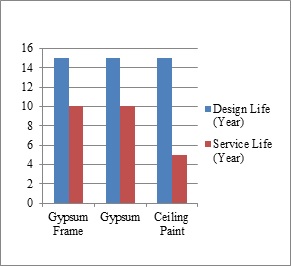Estimasi Biaya Pemeliharaan Bangunan Mall di Indonesia (Studi Kasus Kota Palembang)
Estimated Maintenance Costs for Mall Buildings in Indonesia (Case Study of Palembang City)
DOI:
https://doi.org/10.25299/saintis.2022.vol22(01).9150Keywords:
Bahan Komponen Bangunan, Umur Bangunan, Biaya Pemeliharaan Bangunan, Analisis Nilai Masa DepanAbstract
[ID] Di kota besar seperti Palembang terdapat beberapa bangunan mall yang telah berusia belasan tahun dan mengalami kerusakan arsitektur. Salah satu faktor penyebab kerusakan dikarenakan masa pakai bangunan atau yang disebut dengan degradasi. Untuk mengembalikan kondisi bangunan ke keadaan semula dan memperpanjang umur bangunan, diperlukan pemeliharaan dengan melakukan perbaikan atau penggantian komponen bangunan. Pemeliharan bangunan memerlukan biaya yang terencana. Hal yang menjadi fokus penelitian ini adalah pemeliharaan preventif dan corrective. Tujuan penelitian ini adalah menghitung estimasi besaran biaya pemeliharaan bangunan untuk 10 tahun mendatang. Metode Composite Condition Index digunakan untuk menghitung besar tingkat kerusakan bangunan. Penggantian komponen bangunan dilakukan dengan memprediksi kondisi komponen bangunan, sedangkan estimasi biaya pemeliharaan menggunakan metode analisis nilai masa depan. Analisis data menggunakan data kuantitatif dengan variabel penelitian adalah semua biaya pemeliharaan. Hasil perhitungan menunjukkan nilai Indeks Kondisi Bangunan untuk komponen arsitektur bangunan mall adalah 76,24% yang berarti ada 23,76% kerusakan bangunan. Kerusakan terbesar terjadi pada area koridor yaitu sebesar 25,47% dengan Indeks Kondisi Bangunan sebesar 74,53%. Biaya pemeliharaan tertinggi terjadi pada tahun ke-7 sebesar USD 580,854. Biaya ini meningkat 5,8 kali lipat dibandingkan tahun pertama, dengan penggantian material komponen terbesar untuk komponen lantai dan pengecatan dinding.
[EN] In a big city like Palembang, several mall buildings are a dozen years old and have architectural damage. One factor that causes damage is the life of the building or what is called degradation. Maintenance is required to restore the condition of the building to its original state and extend its life. Maintenance is done by repairing or replacing building components. Building maintenance requires planned costs. This research focuses on preventive and corrective maintenance. This study aims to calculate the estimated cost of building maintenance for the next ten years. We used the Composite Condition Index method to calculate the level of damage to the building. Replacement of building components was done by predicting the condition while estimating maintenance costs using the future value analysis method. Data analysis using quantitative data with research variables are all maintenance costs. The calculation results show the Building Condition Index value for the architectural component of the mall building is 76.24%, which means there is 23.76% building damage. The most significant damage occurred in the corridor area, 25.47%, with 74.53% a Building Condition Index. The highest maintenance costs happened in the 7th year of USD 580,854. Compared to the first year, this cost increased 5.8 times, with the most extensive component material replacement for flooring and wall painting components.
Downloads
References
M. L. Coutinho, A. Z. Miller, and M. F.
Macedo, “Biological Colonization and Biodeterioration of architectural ceramic materials : An overview,” J. Cult. Herit., pp. 1–19, 2015, doi: 10.1016/j.culher.2015.01.006.
F. Andrés José Prieto Ibánez, Juan Manuel Macías Bernal, María José Chávez de Diego
and J. A. Sánchez, “Expert System for Predicting Buildings Service Life under ISO 31000 Standard. Application in Architectural Heritage,” J. Cult. Herit., pp. 1–10, 2015, doi: 10.1016/j.culher.2015.10.006.
D. Besiktepe, M. E. Ozbek, and R. A. Atadero, “Analysis of the Maintenance Work Order Data in Educational Institutions,” in Interdependence between Structural Engineering and Construction Management, 2019, pp. 1–6, doi: 10.14455/ISEC.res.2019.18.
A. Farahani, H. Wallbaum, and J. Dalenbäck, “Optimized Maintenance and Renovation Scheduling in Multifamily Buildings – A Systematic Approach Based on Condition State and Life Cycle Cost of Building Components,” Constr. Manag. Econ., vol. 37, no. 3, pp. 139–155, 2019, doi: 10.1080/01446193.2018.1512750.
C. Ferreira, A. Silva, J. De Brito, I. S. Dias, and I. F. Colen, “The Impact of Imperfect Maintenance Actions on The Degradation of Buildings’ Envelope Components,” J. Build. Eng., vol. 33, no. February 2020, pp. 1–10, 2021, doi: 10.1016/j.jobe.2020.101571.
S. Nurul, A. Mohd, N. Norazman, A. Irfan, and C. Ani, “Occupants Satisfaction Towards Building Maintenance of Low-Cost Building Apartment In Kajang : Pilot survey,” vol. 12, no. 3, pp. 2253–2264, 2021.
N. Jewell, Shopping Malls and Public Space in Modern China. 2015.
P. F. Kaming, “Implementation of Life Cycle Costing for a Commercial Building : Case of a Residential Apartment at Yogyakarta,” in MATEC Web of Conferences, 2017, vol. 138, pp. 1–10, doi: 10.1051/matecconf/201713805008.
E. F. M. Joseph, “Investigation of Maintenance and Cost Control For High Rise Building,” Int. Res. J. Eng. Technol., vol. 06, no. 02, pp. 1968–1979, 2019.
A. T. H. Le, N. Domingo, E. R. Park, and K. Sungho, “Building Maintenance Cost Planning and Estimating: A Literature Review,” in Thirty-Fourth Annual Conference, 2018, pp. 697–706.
J. Tamosaitiene, H. Sarvari, M. Cristofaro, and D. W. M. Chan, “Identifying and Prioritizing The Selection Criteria of Appropriate Repair and Maintenance Methods for Commercial Buildings,” in International Journal of Strategic Property Management, 2021, vol. 25, no. 5, pp. 413–431.

Downloads
Published
Issue
Section
License

This work is licensed under a Creative Commons Attribution-ShareAlike 4.0 International License.
Copyright. This is an open access article which means that all content is freely available without charge to the user or his/her institution. Jurnal Saintis allows the author(s) to hold the copyright without restriction. The copyright in the text of individual articles (including research articles, opinion articles, and abstracts) is the property of their respective authors distributed under the terms of the Creative Commons Attribution-ShareAlike 4.0 International License which permits unrestricted use, distribution, and reproduction in any medium. Users are allowed to read, download, copy, distribute, search, or link to full-text articles in this journal without asking by giving appropriate credit, provide a link to the license, and indicate if changes were made.





